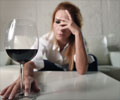With the belief that it will lead to positive mood changes, many young adults are turning to high-risk drinking

"A large body of research has shown that the majority of adolescents and young adults report [having] social and enhancement motives for drinking alcohol," said Marie Eliasen, a research assistant at the University of Southern Denmark as well as corresponding author for the study. "These motives can include: 'it makes social gatherings more fun,' 'to get in a party mood,' and 'because it's fun.' Comparing nationalities, social and enhancement motives were especially prevalent in North America and northern and mid-Europe, while for example in Spain, the most frequent motives of drinking among young adults were that they liked the taste and that it was a custom/social habit."
Eliasen explained that in Denmark, there exist no national or regional restrictions or policies on selling and drinking alcohol at high-school parties; students are allowed to drink and buy alcohol regardless their age as these functions are regarded as private and thus the age limit for purchasing alcohol is not enforced. "At least since the 1960s and probably also before that, students have bought and drank alcohol at these parties," she said. "In the last couple of years, a few Danish high schools have introduced alcohol-free parties, but we do not have any exact statistics. It is still the norm to serve alcohol at the parties at the majority of Danish high schools."
Eliasen and her colleagues examined 230 Danish high-school students (151 girls, 79 boys) aged 15 to 20 years who were attending high school parties. During the parties, the students visited an examination room located near the party in one-hour intervals to have their BAC and levels of cheerfulness, focus distraction, and sluggishness measured. BACs were measured by means of a breath analyzer, while cheerfulness (on a score from 0-16), focus distraction (score from 0-8), and sluggishness (score from 0-4) were self-reported.
"We found that low to moderate alcohol consumption is associated with increased cheerfulness among adolescents attending high-school parties," said Eliasen. "Extensive alcohol consumption leading to high BACs was associated with decreased cheerfulness among girls while this was not found for boys. However, few boys had very high BACs, which makes it difficult to draw conclusions. In addition, alcohol consumption increased focus distraction among these students. Another interesting finding was that the majority of the participating students had low to moderate BACs, indicating that they did not drink as much alcohol as is normally presumed."
Advertisement
"These findings show alcohol's subjective effects in a real-life setting," said Eliasen. "The participants were followed over time, acting as they normally did at a party, including deciding themselves how much to drink. It is important to incorporate the context in which alcohol is consumed in order to obtain full knowledge about alcohol's subjective effects, as the context has been shown to have a high impact on the subjective effects of alcohol."
Advertisement
Source-Eurekalert













